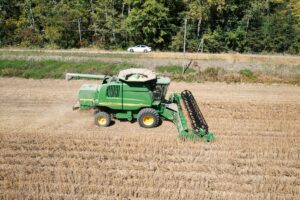A tractor is more than just a piece of equipment—it’s an investment and an essential tool for farming, landscaping, or property maintenance. Like any machinery, regular maintenance is key to ensuring your tractor operates efficiently and lasts for years. Proper care not only extends its lifespan but also prevents costly breakdowns and enhances performance. This comprehensive guide will teach you how to maintain your tractor like a pro, covering essential tips, routine inspections, and advanced maintenance techniques.
Why Tractor Maintenance Is Important
Regular maintenance offers several benefits:
- Efficiency: A well-maintained tractor runs smoothly, using less fuel and delivering optimal performance.
- Longevity: Routine care prevents wear and tear, prolonging the tractor’s lifespan.
- Safety: Proper maintenance minimizes the risk of accidents caused by mechanical failures.
- Cost Savings: Preventative maintenance reduces repair costs and downtime, saving money in the long run.
Daily Tractor Maintenance Checklist
Daily maintenance is crucial for ensuring your tractor is ready for work. Before using your tractor each day, follow this simple checklist:
1. Inspect Fluids
- Engine Oil: Check the oil level using the dipstick and add oil if it’s low. Replace it if it appears dirty or cloudy.
- Coolant: Ensure the coolant reservoir is at the appropriate level to prevent overheating.
- Hydraulic Fluid: Inspect the hydraulic system for leaks and check the fluid level.
- Fuel: Fill up the tank to avoid running out during operation.
2. Check Tires
- Tire Pressure: Use a pressure gauge to confirm that tires are inflated to the recommended levels.
- Tread Condition: Inspect for cracks, punctures, or excessive wear.
3. Clean the Tractor
- Remove Debris: Clear dirt, mud, and crop residue from the tires, chassis, and implements.
- Clean Radiator Screen: Prevent overheating by removing debris from the radiator screen and cooling system.
4. Inspect Attachments
- Ensure all implements are securely attached and properly aligned. Check for damaged or worn parts on attachments like mowers, plows, or loaders.
Weekly Tractor Maintenance Tasks
Besides to daily checks, perform these tasks weekly to keep your tractor in top condition:
1. Inspect Belts and Hoses
- Check for signs of wear, cracks, or fraying on belts.
- Look for leaks, bulges, or cracks in hoses. Replace damaged components immediately.
2. Grease Moving Parts
- Apply grease to all moving parts, such as pivot points, joints, and bearings, to reduce friction and prevent wear.
3. Test Battery
- Inspect battery terminals for corrosion and ensure cables are tightly connected.
- Use a multimeter to check the battery’s voltage and recharge if necessary.
4. Inspect Lights and Indicators
- Test headlights, taillights, and warning lights to ensure they’re functioning correctly, especially for tractors used on public roads.
Monthly Tractor Maintenance
Monthly maintenance involves more in-depth inspections and servicing:
1. Change Engine Oil and Filter
- Replace engine oil and oil filters according to the manufacturer’s recommendations. This step is vital to maintaining engine health.
2. Replace Fuel Filters
- Clean or replace fuel filters to prevent clogging and ensure a steady fuel supply to the engine.
3. Clean the Air Filter
- Remove the air filter and clean it with compressed air or replace it if it’s excessively dirty. A clean air filter improves engine efficiency.
4. Inspect Brakes
- Test the brakes to ensure they engage smoothly and provide adequate stopping power. Adjust or replace brake pads as needed.
5. Inspect the PTO System
- Check the Power Take-Off (PTO) system for proper operation. Inspect shafts and connections for wear or damage.
Seasonal Tractor Maintenance
Tractors experience different demands depending on the season. Adjust your maintenance routine accordingly:
1. Before Planting Season
- Tune-Up: Perform a comprehensive tune-up, including checking all fluid levels, filters, and spark plugs.
- Inspect Implements: Ensure all implements are ready for planting tasks, such as plows, seeders, and harrows.
- Test Hydraulic Systems: Confirm that hydraulic lifts and controls are functioning correctly.
2. Mid-Season Maintenance
- Inspect Wear Points: Check high-use components like belts, blades, and tires for wear.
- Lubrication: Reapply grease to moving parts to prevent seizing.
3. End-of-Season Maintenance
- Clean Thoroughly: Wash the tractor to remove dirt, debris, and corrosive substances like fertilizer.
- Drain Fluids: Drain and replace old fluids, including oil, coolant, and fuel.
- Storage Prep: Store the tractor in a dry, covered area. Use a tarp or cover to protect it from dust and moisture.
Advanced Maintenance Tips
For more experienced tractor owners, these advanced maintenance tasks ensure your tractor stays in optimal condition:
1. Maintain the Transmission
- Change transmission fluid and filters as recommended by the manufacturer.
- Inspect gears and clutches for smooth operation.
2. Calibrate Implements
- Adjust implement settings, such as depth and angle, to ensure proper operation and avoid uneven wear.
3. Maintain the Hydraulic System
- Flush and replace hydraulic fluid regularly to prevent contamination.
- Inspect cylinders, hoses, and seals for leaks or damage.
4. Monitor Engine Performance
- Listen for unusual noises, such as knocking or rattling, which could state engine issues.
- Use diagnostic tools to analyze engine performance metrics.
Common Tractor Maintenance Mistakes to Avoid
- Neglecting the Owner’s Manual: Always follow the manufacturer’s guidelines for maintenance schedules and procedures.
- Overlooking Small Issues: Address minor problems promptly to prevent them from escalating into major repairs.
- Using Incorrect Fluids: Use only the recommended oils, coolants, and hydraulic fluids to ensure compatibility.
- Ignoring Safety Features: Regularly inspect safety components like ROPS (Roll-Over Protection Structure) and seat belts.
- Skipping Maintenance: Skipping routine maintenance to save time or money often leads to costly repairs later.
Top Tools for Tractor Maintenance
Investing in the right tools can make tractor maintenance easier and more effective:
- Grease Gun: Essential for lubricating moving parts.
- Tire Pressure Gauge: Ensures proper tire inflation.
- Socket Set: Useful for tightening or removing bolts.
- Multimeter: Measures battery voltage and electrical performance.
- Oil Filter Wrench: Simplifies oil filter changes.
- Power Washer: Keeps the tractor clean and free from debris.
When to Call a Professional
While many maintenance tasks can be performed at home, some issues need professional expertise:
- Major Engine Repairs: Unusual noises, excessive smoke, or persistent power loss may signal a need for professional intervention.
- Transmission Issues: Slipping gears or grinding noises often state complex transmission problems.
- Hydraulic Failures: If the hydraulic system consistently leaks or fails to operate, it’s best to consult a technician.
Conclusion
Maintaining your tractor like a pro doesn’t have to be complicated. By following a regular maintenance schedule, inspecting key components, and addressing issues promptly, you can keep your tractor running smoothly for years. Whether you’re a farmer, landscaper, or property owner, investing time and effort into proper care ensures that your tractor remains a reliable partner in all your projects.
With the tips and techniques outlined in this guide, you’re well-equipped to maintain your tractor, avoid costly repairs, and maximize its performance. Treat your tractor like the valuable asset it is, and it will reward you with years of dependable service.



